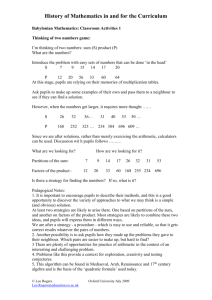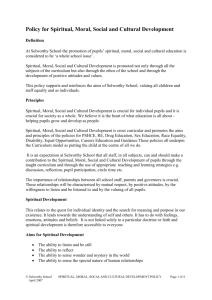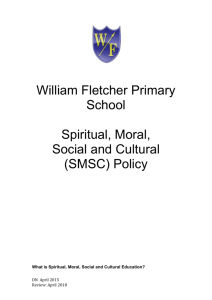Spiritual and moral development in Mathematics
advertisement
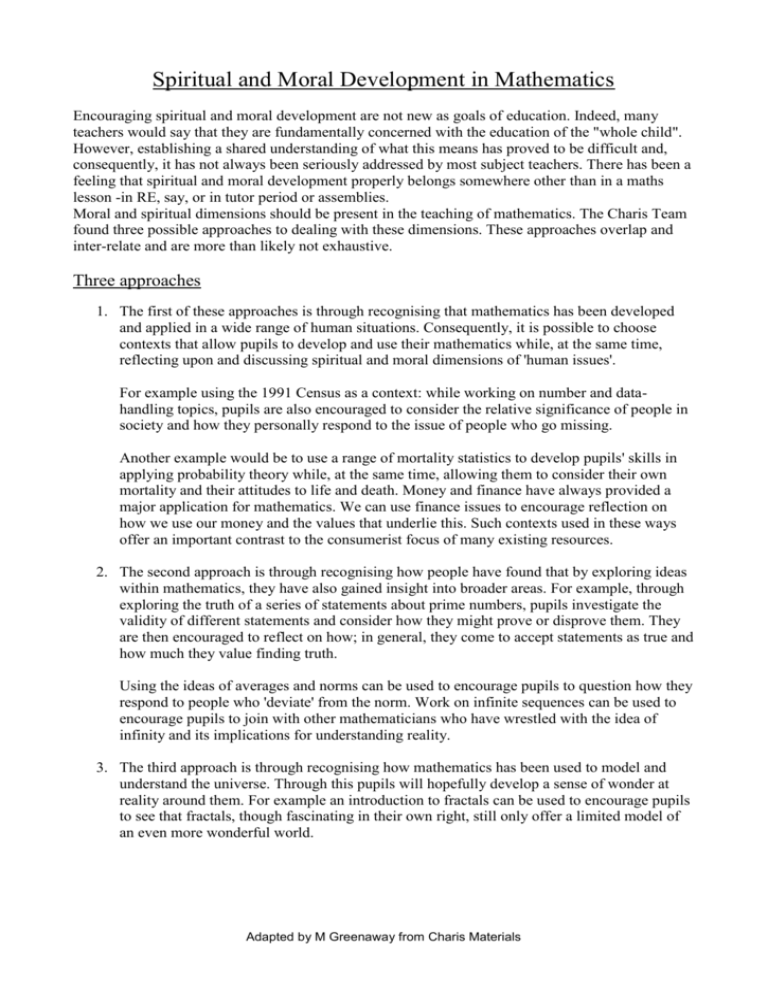
Spiritual and Moral Development in Mathematics Encouraging spiritual and moral development are not new as goals of education. Indeed, many teachers would say that they are fundamentally concerned with the education of the "whole child". However, establishing a shared understanding of what this means has proved to be difficult and, consequently, it has not always been seriously addressed by most subject teachers. There has been a feeling that spiritual and moral development properly belongs somewhere other than in a maths lesson -in RE, say, or in tutor period or assemblies. Moral and spiritual dimensions should be present in the teaching of mathematics. The Charis Team found three possible approaches to dealing with these dimensions. These approaches overlap and inter-relate and are more than likely not exhaustive. Three approaches 1. The first of these approaches is through recognising that mathematics has been developed and applied in a wide range of human situations. Consequently, it is possible to choose contexts that allow pupils to develop and use their mathematics while, at the same time, reflecting upon and discussing spiritual and moral dimensions of 'human issues'. For example using the 1991 Census as a context: while working on number and datahandling topics, pupils are also encouraged to consider the relative significance of people in society and how they personally respond to the issue of people who go missing. Another example would be to use a range of mortality statistics to develop pupils' skills in applying probability theory while, at the same time, allowing them to consider their own mortality and their attitudes to life and death. Money and finance have always provided a major application for mathematics. We can use finance issues to encourage reflection on how we use our money and the values that underlie this. Such contexts used in these ways offer an important contrast to the consumerist focus of many existing resources. 2. The second approach is through recognising how people have found that by exploring ideas within mathematics, they have also gained insight into broader areas. For example, through exploring the truth of a series of statements about prime numbers, pupils investigate the validity of different statements and consider how they might prove or disprove them. They are then encouraged to reflect on how; in general, they come to accept statements as true and how much they value finding truth. Using the ideas of averages and norms can be used to encourage pupils to question how they respond to people who 'deviate' from the norm. Work on infinite sequences can be used to encourage pupils to join with other mathematicians who have wrestled with the idea of infinity and its implications for understanding reality. 3. The third approach is through recognising how mathematics has been used to model and understand the universe. Through this pupils will hopefully develop a sense of wonder at reality around them. For example an introduction to fractals can be used to encourage pupils to see that fractals, though fascinating in their own right, still only offer a limited model of an even more wonderful world. Adapted by M Greenaway from Charis Materials SPIRITUAL, MORAL, ETHICAL, SOCIAL AND CULTURAL ISSUES During the course there are opportunities to promote candidates spiritual, moral, social and cultural development. Spiritual development: through helping candidates obtain an insight into the infinite, and through explaining the underlying mathematical principles behind natural forms and patterns. Moral development: helping candidates recognise how logical reasoning can be used to consider the consequences of particular decisions and choices and helping them learn the value of mathematical truth. Social development: through helping candidates work together productively on complex mathematical tasks and helping them see that the result is often better than any of them could achieve separately. Cultural development: through helping candidates appreciate that mathematical thought contributes to the development of our culture and is becoming increasingly central to our highly technological future, and through recognising that mathematicians from many cultures have contributed to the development of modern day mathematics. Adapted by M Greenaway from Charis Materials


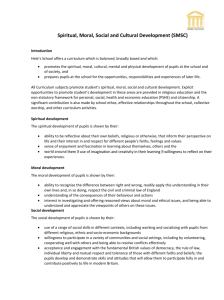

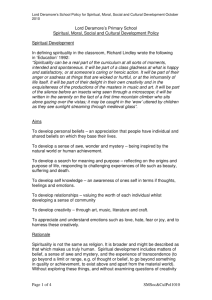

![afl_mat[1]](http://s2.studylib.net/store/data/005387843_1-8371eaaba182de7da429cb4369cd28fc-300x300.png)

